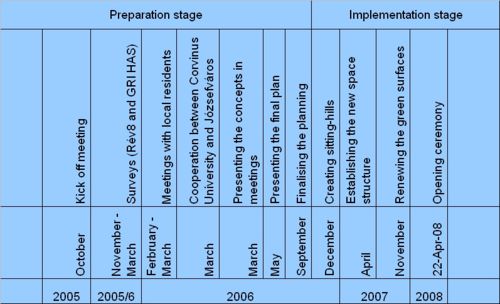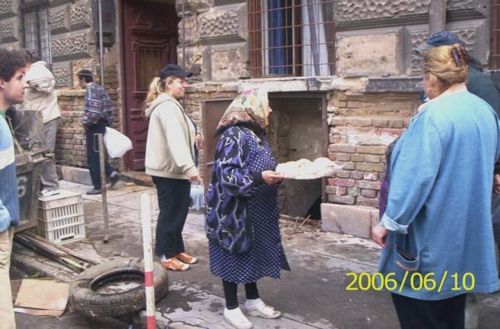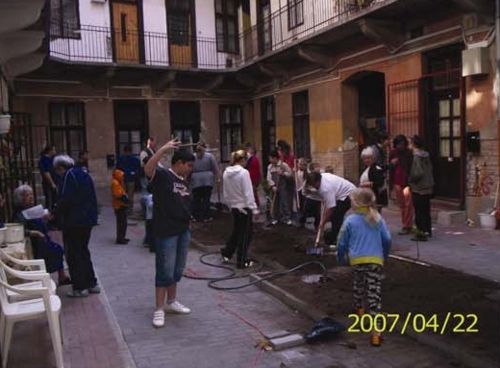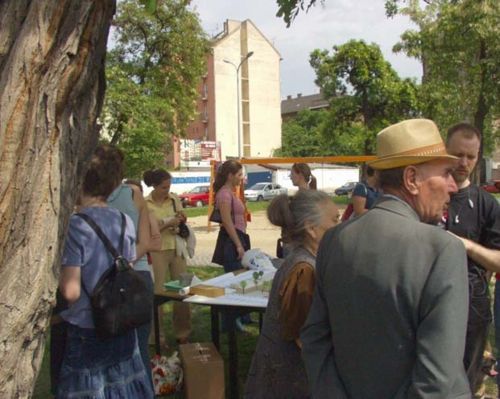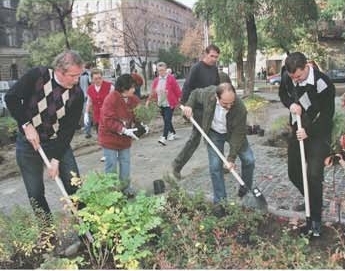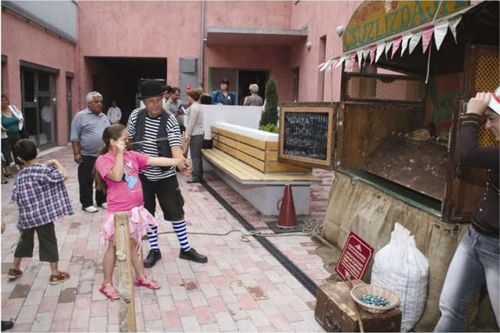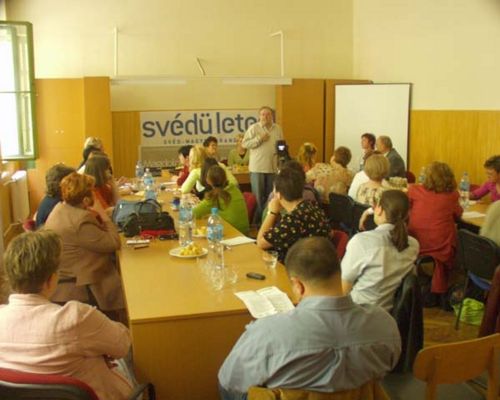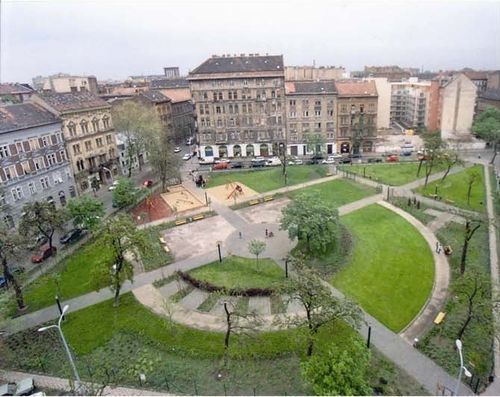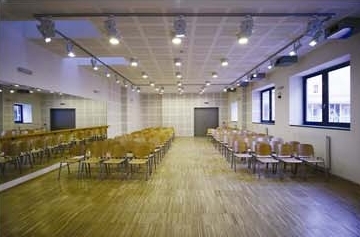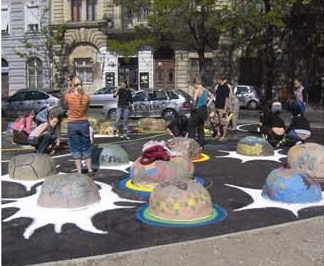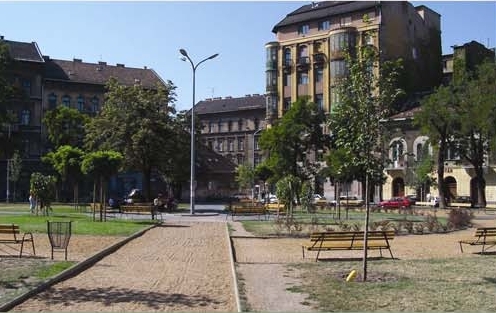Budapest-Józsefváros: Difference between revisions
| Line 89: | Line 89: | ||
For organizers of this initiative was important not only to utilize the public space but to strengthen the cohesion of the different social groups and let them feel of the new green area as their own property. (table: author based on Rev8 sources) | For organizers of this initiative was important not only to utilize the public space but to strengthen the cohesion of the different social groups and let them feel of the new green area as their own property. (table: author based on Rev8 sources) | ||
<gallery caption=" " widths="500px" heights="400px" perrow="5"> | |||
Image:tabela3.jpg|''Time schedule of implementation of the Mátyás Square(author)'' | |||
Revision as of 07:59, 22 February 2009
Regeneration Program in Budapest - Józsefváros
Renewal of retarded urban district with the involvement of the residents
Rationale: Why is this case study interesting?
The Magdolna Quarter Program (Budapest – Józsefváros) is the first trial in Hungary to implement renewal of multiple retarded urban district with the involvement of the residents including integrated social, cultural and technical measures. It is a significant new initiative in the history of urban planning in Budapest because it takes under consideration all three fields of urbanity – society, economy and environment and especially because it includes the intensive social involvement in the process of urban development of this area. The implementation of the spatial planning aims is difficult in the Magdolna Quarter because of extreme in the scale of the city social and economical problems there and the achievement of the urban landscape assumptions calls for complex, integrated acting in several fields in the same time.
In the frame of this program have been realized 7 sub-programs - three first of them deserve for a special attention of landscape architects and planners. The program of ‘The building renewal by involvement of the tenants’, ‘The renewal of Mátyás square’ and the 'Glove Factory - Community House' are a good practice of social inclusion in all the phases of urban development process, since the moment of planning until the realization of the particular projects. Here the fact of involvement of the local society in design of the public areas is not merely the urban landscape issue but has also the educational, economical, crime prevention and social awareness building aspects.
The most interesting in those projects is the complexity of urban planning and the way of involving the problematic and socially disable community in urban landscape development and designing of the public spaces. The Magdolna Quarter Program express the interactions between urban landscape and society and help to understand the variety of needs of target groups when designing public spaces.
Author's perspective
There are many similar towns, especially located in East Europe, that struggle with problems of stagnate development of the poorest areas. This is of particular importance in case of these deteriorating cities or city quarters, which are depended on incomes of local society and entrepreneurs, and which slowly became the social and economical ‘bankrupts’ being unable to make itself a step ahead. The Budapest case is an interesting example of regenerating of city quarter by simultaneous development of its economy, spatial structure and social involvement.
I had an occasion to observe the development of Magdolna Quarter Program and the implementation of one of the public spaces there by participating in EU - financed project 'GreenKeys- Urban Green as a Key for Sustainable Cities', in which the Matyas Square have been a sample area of new Urban Green Strategy.
The aims and contents of the Program
The most important of this program is to introduce new model of urban rehabilitation scheme in Hungary where the local society of the area is actively involved in all the elements of the program. It should be kind of catalyst for public initiatives and motivate both local authorities and society to self improvement of the quality of live in problematic districts.
The Magdolna Quarter Program based on 3 general aims:
social – to improve the standard of living by ensuring appropriate living conditions, involvement of current residents, strengthening the local community cohesion and retaining the social diversity.
economical – to improve the earning production and self-reliance of the area, development of the local labour market and reduction of unemployment.
environmental – to enlarge the public and green areas both by size and quality, creating sustainable living environment by successive renovation of old buildings and retaining of architectural values of the new ones.
Contest of the program:
Program #1 – Building renewal by involvement of the tenants.
Program #2 – Greenkeys project – Renowal of the Mátyás square.
Program #3 – Mátyás Square Community House ‘Glove Factory’.
Program #4 – Education Program.
Program #5 – Crime prevention program.
Program #6 – Employment, entrepreneus program.
Program #7 – Community development program.
Implementation of the Program
Start the Program
Budapest City Council and Local Government of Józsefváros decided about the needs of providing an integrated experimental urban regeneration program in 2004. Based on this decision the Rév8 PLC (Józsefváros Rehabilitation and Urban Development Company) cooperating with local authorities elaborated and developed the Magdolna Quarter Program, as a kind of medium-term regeneration initiative for period of 15 years. The experiment program took a place as a co-operation part between 2005 and 2008.
The Program #1 - Building renewal by involvement of the tenants - works with 100% Local Government (LG) owned rented houses. P#1 has been started with 6 houses in 2005 and then continued with 4 houses more. The tenants have been involved already in design part of the renewal program of the house. The proposed tasks and the renewal works was defined together with residential community. After that Rév8 PLC continually maintain contacts with the residents of each house and provided information about the opportunities available for the renewal of the houses. The support by their professional experience have been provided for the residents in process of making their decision.
During the renovation there has been an opportunity for tenants to nominate a representative or a ‘commission’ for the negotiations with Rév8 PLC. Some smaller works have been done by the tenants against some remuneration that could be compensation in the rentals, reduction of rent unpaid or accounting for material costs.
The removal of Mátyás Square Program #2 have been a first action of the Magdolna Quarter Program in public areas. The aim of this initiative was to develop a common community place where people can gather and arise the social relationships that could increase the resident retention force of the neighborhood and enhance the living standards of the quarter. The square was at the same time a sample area (pilot project) for GreenKeys Project (Urban Green as a Key for Sustainable Cities) realized in 2005-2008 with support of EU funds. In the first phase of design the Rev8 PLC have consulted the ideas with academic researchers and professionals from EU. In year 2006 the design part took a place that have been realized with closed cooperation with local residents. Several meetings with residents have been organized during which they participated in designing and deciding process about plans and materials. The implementation phase started in autumn 2006 and some of the small works like sittings mounds – new street furniture – have been realized by teachers and pupils from local schools.
For organizers of this initiative was important not only to utilize the public space but to strengthen the cohesion of the different social groups and let them feel of the new green area as their own property. (table: author based on Rev8 sources)
- The '''Program
- The '''P
- The objective of '''P
- The '''P
- The last but not the least to implement is the '''P
- === Landscape and/or urban context===
- Devaluation of the area (Egedy, 2008). The quarter is located in the heart of the district. the territory is 340.000 square meters large and had 12.000 inhabitants.
- === Cultural/social/political context===
- The ratio of small area flats without any comfort is high in the outdated composition and extraordinarily bad state flat stock.
- === History ===
- === Spatial analysis of area/project/plan===
- === Core Questions Working Group Public Space and Civic Identity ===
- ==== Who was involved in the participation process? ====
- Players in different parts of project implementation:
- 1. Initiation of the program:
- - Municipality of Budapest
- - Local Government of Józsefváros
- 2. The preparatory of the project (planning, analyzing, designing)
- - Geographical Research Institute of Hungarian Academy of Science GRI HAS
- - Rév8 - Urban Renewal and Development of Józsefváros PLC
- - Budapest Corvinus University
- 3. Financial participation:
- City of Budapest, Local Government of Józsefváros, EU institutes in a frame of INTERREG III B program, project GreenKeys- Urban Green as a Key for Sustainable Cities.
- 4. Maintenance of realized project:
- Local Government with participation of local society.
- (Illustr. - author )
- ==== How was the participation process implemented (methods applied)? ====
- Planning and design phase:
- Besides these a survey was carried out in the period of the end of 2005
- And the beginning of 2006. The results of the survey have been analyzed by
- In March 2006 have been invited to the program the Corvinus University to cooperate in with District in the planning and implementation of the project.
- Based on the comments and demands of the local inhabitants, three different
- Implementation:
- The implementation activity was divided into two parts.
- The second phase was the establishing a new playground and fences, new public lighting and security service. New plants were placed on the square by residents, politicians and NGO’s during two days of voluntary work in autumn 2007.
- Maintenance.
- ==== In how far does/did the project respond to people's needs? ====
- === Analysis of program/function ===
- Up to the kind of sub-programs - please see the implementation part above.
- === Analysis of design/planning process ===
- === Analysis of use/users ===
- === Future development directions ===
- === Peer reviews or critique ===
- GreenKeys Project Team (2008) GreenKeys@Your City - A Guide for Urban Green Quality, Korotan d.o.o, Lubljana
- Egedy, T. (2008) The role of monitoring and the Greenkeys Monitoring System, in: Urban Green Spaces - A Key for Sustainable Cities: Conference Reader. International Conference,
- === Points of success and limitations ===
- === What can be generalized from this case study? ===
- The more diversified participants in process of creating the public spaces the more people is satisfied from the final effect.
- The renovation of inhibited urban area should be done with involvement of local society.
- The reactivation of poorest city area have to be done simultaneously with development of local community and with its acceptance.
- The involvement of society in the process of improving public spaces build the feeling of responsibility for this space.
- === Which research questions does it generate? ===
- Keywords/issues: social participation, reactivation of slums, improving the living conditions of poorest urban areas, working in the roots, development of community life and social awareness, public spaces, urban green in poorest part of city, etc.
- === Image Gallery ===
- (pic. Rev8, land. arch. Tamas Dömötör )
References
All the information and illustrations used in this case study description come from Rev8 PLC, from available public domain sources or are the authors conclusions and summaries.
I would like to thank this way Rev8 PLC from Budapest for their help, the materials and the pictures.
More information about the program can be found on:
Budapest Mid-Term Urban Development Program www.budapest.hu
Magdolna Regeneration Model Program www.rev8.hu
Jozsefvaros Mid-Term Urban Development Program www.jozsefvaros.hu
Digital Childhood Program www.kidpix.hu
Interreg IIIB CADSES GreenKeys www.greenkeys-project.net
Budapest Corvinus Univercity www.bce.hu
Geographical Research Institute of the Hungarian Science Academy www.mta.hu
8.District Police Department www.brfk.hu
Alföldi, Gy., Kovács, Z. (2008) The future of our cities – joint responsibility and joint green action, in: Alföldi, Gy., Kovács, Z. (eds.) Városi Zöld Könyv – Urban Green Book, pp. 100–103. Budapest, published by ÉTK, MTA FKI, Rév8 Zrt.
Bajomi, I. (undated) Education of underprivileged children in a deteriorated neighborhood of Budapest. Available at: http://www.girsef.ucl.ac.be/bajomi.pdf (Date accessed, 02. 09. 2008).
Beluszky, P. (2007) A Kárpát-medence régiói 6. Közép-Magyarország (Regions of Carpathian Basin 6. Middle-Hungary). Pécs-Budapest, Dialóg Campus.
Berényi, E., Kondor, A. Cs., Szabó, B. (2008) The social aspects of green areas in Budapest with special regard to migration questionnaire research in six sample areas, in: Alföldi, Gy., Kovács, Z. (eds.) Városi Zöld Könyv – Urban Green Book, pp. 104–121. Budapest, published by ÉTK, MTA FKI, Rév8 Zrt.
Boros, T-né (1993) Városi zöldterületek társadalmi haszna és költsége (The social benefit of urban green spaces). Budapest, Országos Műszaki Információs Központ és Könyvtár.
Dövényi, Z., Kovács, Z. (1999) A szuburbanizáció térbeni-társadalmi jellemzői Budapest környékén (Spatial-social features of suburbanisation around Budapest). Földrajzi Értesítő (Geographical Bulletin), 48(1–2), pp. 33–57.
Rev8 PLC, art. Challenges and Experiences of a Participative Green Space Development in Budapest-Józsefváros
About categories: You can add more categories by copying the tag and filling in your additional categories

